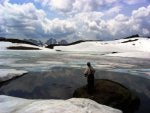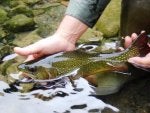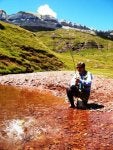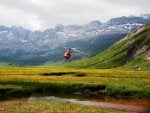salvelinus
New member
- Messages
- 1
- Reaction score
- 0
SPAIN
An unknown fly fishing destination with high tourist interest
Spain is placed in very interesting latitude: sufficiently northern to shelter great quantity of trout and the sufficiently hot to make it different from the rest of European countries.
Undoubtedly the Spanish climate in combination with injured of the topography of the mountains, do of this destination an idyllic place for the dry fly.
Special anglers enjoy each season with the traditional concept of Dry Fly Fishing for native Brown Trout, wading, upstream and using fine lines with dries, at the same time you discover the most hidden and beautiful spots in the rivers of the old Europe, fished by Hemingway.
The Mountains and Rivers of Northern Spain
The large natural border between France and Spain, the Pyrenees, offers a lifetime experience fly fishing for native trout on rivers and lakes set amongst wild and unspoilt landscapes.
There are interesting places in Spanish Pyrenees in North Eastern Navarre, North Aragon and North Western Cataluña. The Aragonese Pyrenees, Huesca, is the province with the majority of the High Spanish Pyrenees. It is situated between Navarre and Catalonia Pyrenees.
Andorra Pyrenees could be another good option to go to fish inside Ibons.
The conditions of the rivers in French Pyrenees are really different. Some of the best rivers in France are very recommendable for nymph due to the higher level of colder water along the open season. Mostly of rivers are open to life bait fishing. Some high mountain lakes in the north face, are a very good option for dries in latest summer.
The Navarre , Aragonesee and Catalonia Pyrenees
The Navarre and Aragonese Pyrenees are considered the most primitive place in Western Europe, today. There are only a few areas in the world with such an enormous variety of climates, altitudes and landscapes than Western and Eastern Pyrenees destinations. The Navarra Pyrenees area is consider Pre-Pyrenees with more relaxed valleys and mountains. There are the famous rivers fished by Hemingway when he was attending the Sanfermines bullfighting fiestas in the 20's and again in the late 50's.
Aragon, Huesca is situated between Navarra and Catalonia Pyrenees. The word “Aragon” comes from a language older than Celtic (13th Century B.C.) meaning region of water courses. This gives the visitor an idea of the region’s ancient, close ties with the waters of the Pyrenees. Thousand-year old traditions, a product of this region’s long history, have created a rich cultural heritage set in an extraordinary variety of landscapes.
The total population of the region is around 1 million inhabitants, some 650,000 of which live in the capital city, Zaragoza. This means that the overall density of population in Aragon is very low. In the mountainous northern province of the region, Huesca there are only some 20 inhabitants per square mile. This means there are extensive areas of wild, unspoilt countryside cut by rivers and streams and dotted by lakes and tarns for you to enjoy.
The River Ebro and its tributaries form the main river system of Northern Spain. The rivers of the Aragonese Pyrenees alone constitute more than 50% of this system. Additionally this region, the central section of the Pyrenees, is home to most of the sub-systems, valleys and 3000- metre peaks.
Western Catalonia Pyrenees has some locations with a good population of trout. There are some “cotos de pesca” where the Catalonia Administration stock rainbow inside. There are other areas where you could find wild brown trout population. These valleys are situated in the westernest Catalonian Pyrenees, close to Aragonsean Pyrenees and Andorra Pyrenees.
Here we find some of the most preserved area in Catalunya: Aigües Tortes National Park with its tributary of Noguera Rinagorzana River.
PYRENEES: WATERS FOR DRY FLY FISHING
You will be able to feel the immersion in an old an rich culture and enjoy discovering valleys, monasteries, national parks and picks up 9000 foot while... going fishing to spectacular sceneries with pristine waters and without seeing others fishermen.
There are the famous rivers fished by Hemingway when he was attending the Sanfermines bullfighting fiestas in the 20's and again in the late 50's. With over 800 miles of water courses to choose from, there is every possible combination of fishing condition to experience but in general these medium-sized rivers have distinct characteristics:
Source: typical high mountain streams with large rocks and rapids.
Mid-section: more comfortable fishing with smaller rocks, rapids, churning
pools and calm water with an average width of 10 to 15 yards.
Lower reaches: slower flowing water up to 90 yards wide. The rivers here are between 2 and 6 feet deep so are suitable for wading.
Temperatures vary between 50-60 Fahrenheit (11-17 º C.)
Hidden in high mountains (2000 metres and above), there are a large number of Ibons. “Ibon” is a Pyrenees word for a high-mountain lake of glacial origin. These spectacular lakes are only accessible by trekking on foot for between 2 to 6 hour.
FISHING CONDITIONS IN THE REGION
Fly fishing on these waters in the right season and at the right spot, is one of the most exciting, challenging and enjoyable experiences for the subtle fisherman.
The rivers and the habits of the trout in them are perfect for dry fly lovers: each beat, pool or lake provides a different challenge for this style of fishing which offers the best results over other techniques.
Some of these rivers have been compared with some of the most recognize beautiful medium or small size rivers for fly fishing in Argentina.
Fly fishing in the Pyrenees is for those who are looking for something different. Surrounded by wild, unspoilt countryside, the whole day can be spent without seeing another angler.
Rather than fishing for enormous fish with a sinking line; you will experience the heady sensation of actively and continuously sight-fishing for wild trout between 0.5-2 lb.
FLIES
Insects hatch in abundance from April to September and the variety of species is enormous due to the high quality of the water. The most widely used and successful flies include:
Mayflies & caddis nº 12-18
Stoneflies, flat & cad. Nymphs nº 8-14
It is important not to forget:
Attractors nº 12-16
Varied terrestrial nº 8-12
Streamers in natural colours nº 6-8
Once your reservation is complete we will be happy to provide you with a complete study of the natural flies for each month.
RODS AND LINES
For dry-fly fishing on rivers we suggest rods be 8 to 9 feet and of between 3 to 4 in gauge. Floating line. 8 to 10 foot trailers with a final tippet of 5X to 7X.
For lake fishing we recommend a 9’ or 9’ 6” rod of between 5 to 6 in gauge, floating WF line, 10 to 12 foot trailers and a taper of 2X to 5X.
THE FISHING SEASON IN THE PYRENEES
There are many different restrictions in the different regions, areas and valleys but we could find open water to practise wild trout fishing along:
General
19th March – 15th September Western Pyrenees
1st March – 30th of November Eastern Pyrenees
High Mountain
1st of June – 15th of September Western Pyrenees
15th of May – 30th of September Eastern Pyrenees
* April May: could be a good option in some lower reaches
* June-July and September: prime time for Dry-Fly Fishing
* August: the best temperature for High Mountain Fishing
* October –November: best conditions for the biggest ones
Winter Fishing a few “cotos de pesca” are opened
FISHERY MANAGEMENT
The regional administration is responsible for fisheries management. It is necessary to have a regional (Aragon, Navarra or Cataluña) fishing licence (there is no national fishing licence in Spain).
There are “cotos de pesca”: these fishing betas are between 3 km to 30 km long. Inside these areas is necessary to have a personal day permit in addition to the regional licence.
Legislation is very strict and catch and release is compulsory in most areas although you could find very hidden free areas you are able to kill but where nobody go , and finally…full of trout.
CLIMATE
The southern face of the Pyrenean range, our area, has a very favourable climate.
The average temperature along the season is around 60-80 Fahrenheit but you can not remember you are in Pyrenees Mountains and in the same hour could be a different of 30 degrees between lower reaches and high mountain.
The weather in high mountain could be hard in any season.
In winter snow covers the majority of the trout valleys.
FAUNA & FLORA
The Aragonese Pyrenees has many protected natural areas covering approximately 8% of the region. There are also 200,000 hectares of hunting grounds.
There are many species of wild animals, reptiles and birds in the Pyrenees – from brown bears to fire salamanders. Egyptian, griffon and bearded vulture, golden eagle, dipper, wild boar, sarrio (similar to chamois), mountain goat, eagle owl and red squirrel are all frequent sights to accompany a day’s fishing. There is also the possibility of spotting the elusive Pyrenean Desman in the higher mountains streams.
An unknown fly fishing destination with high tourist interest
Spain is placed in very interesting latitude: sufficiently northern to shelter great quantity of trout and the sufficiently hot to make it different from the rest of European countries.
Undoubtedly the Spanish climate in combination with injured of the topography of the mountains, do of this destination an idyllic place for the dry fly.
Special anglers enjoy each season with the traditional concept of Dry Fly Fishing for native Brown Trout, wading, upstream and using fine lines with dries, at the same time you discover the most hidden and beautiful spots in the rivers of the old Europe, fished by Hemingway.
The Mountains and Rivers of Northern Spain
The large natural border between France and Spain, the Pyrenees, offers a lifetime experience fly fishing for native trout on rivers and lakes set amongst wild and unspoilt landscapes.
There are interesting places in Spanish Pyrenees in North Eastern Navarre, North Aragon and North Western Cataluña. The Aragonese Pyrenees, Huesca, is the province with the majority of the High Spanish Pyrenees. It is situated between Navarre and Catalonia Pyrenees.
Andorra Pyrenees could be another good option to go to fish inside Ibons.
The conditions of the rivers in French Pyrenees are really different. Some of the best rivers in France are very recommendable for nymph due to the higher level of colder water along the open season. Mostly of rivers are open to life bait fishing. Some high mountain lakes in the north face, are a very good option for dries in latest summer.
The Navarre , Aragonesee and Catalonia Pyrenees
The Navarre and Aragonese Pyrenees are considered the most primitive place in Western Europe, today. There are only a few areas in the world with such an enormous variety of climates, altitudes and landscapes than Western and Eastern Pyrenees destinations. The Navarra Pyrenees area is consider Pre-Pyrenees with more relaxed valleys and mountains. There are the famous rivers fished by Hemingway when he was attending the Sanfermines bullfighting fiestas in the 20's and again in the late 50's.
Aragon, Huesca is situated between Navarra and Catalonia Pyrenees. The word “Aragon” comes from a language older than Celtic (13th Century B.C.) meaning region of water courses. This gives the visitor an idea of the region’s ancient, close ties with the waters of the Pyrenees. Thousand-year old traditions, a product of this region’s long history, have created a rich cultural heritage set in an extraordinary variety of landscapes.
The total population of the region is around 1 million inhabitants, some 650,000 of which live in the capital city, Zaragoza. This means that the overall density of population in Aragon is very low. In the mountainous northern province of the region, Huesca there are only some 20 inhabitants per square mile. This means there are extensive areas of wild, unspoilt countryside cut by rivers and streams and dotted by lakes and tarns for you to enjoy.
The River Ebro and its tributaries form the main river system of Northern Spain. The rivers of the Aragonese Pyrenees alone constitute more than 50% of this system. Additionally this region, the central section of the Pyrenees, is home to most of the sub-systems, valleys and 3000- metre peaks.
Western Catalonia Pyrenees has some locations with a good population of trout. There are some “cotos de pesca” where the Catalonia Administration stock rainbow inside. There are other areas where you could find wild brown trout population. These valleys are situated in the westernest Catalonian Pyrenees, close to Aragonsean Pyrenees and Andorra Pyrenees.
Here we find some of the most preserved area in Catalunya: Aigües Tortes National Park with its tributary of Noguera Rinagorzana River.
PYRENEES: WATERS FOR DRY FLY FISHING
You will be able to feel the immersion in an old an rich culture and enjoy discovering valleys, monasteries, national parks and picks up 9000 foot while... going fishing to spectacular sceneries with pristine waters and without seeing others fishermen.
There are the famous rivers fished by Hemingway when he was attending the Sanfermines bullfighting fiestas in the 20's and again in the late 50's. With over 800 miles of water courses to choose from, there is every possible combination of fishing condition to experience but in general these medium-sized rivers have distinct characteristics:
Source: typical high mountain streams with large rocks and rapids.
Mid-section: more comfortable fishing with smaller rocks, rapids, churning
pools and calm water with an average width of 10 to 15 yards.
Lower reaches: slower flowing water up to 90 yards wide. The rivers here are between 2 and 6 feet deep so are suitable for wading.
Temperatures vary between 50-60 Fahrenheit (11-17 º C.)
Hidden in high mountains (2000 metres and above), there are a large number of Ibons. “Ibon” is a Pyrenees word for a high-mountain lake of glacial origin. These spectacular lakes are only accessible by trekking on foot for between 2 to 6 hour.
FISHING CONDITIONS IN THE REGION
Fly fishing on these waters in the right season and at the right spot, is one of the most exciting, challenging and enjoyable experiences for the subtle fisherman.
The rivers and the habits of the trout in them are perfect for dry fly lovers: each beat, pool or lake provides a different challenge for this style of fishing which offers the best results over other techniques.
Some of these rivers have been compared with some of the most recognize beautiful medium or small size rivers for fly fishing in Argentina.
Fly fishing in the Pyrenees is for those who are looking for something different. Surrounded by wild, unspoilt countryside, the whole day can be spent without seeing another angler.
Rather than fishing for enormous fish with a sinking line; you will experience the heady sensation of actively and continuously sight-fishing for wild trout between 0.5-2 lb.
FLIES
Insects hatch in abundance from April to September and the variety of species is enormous due to the high quality of the water. The most widely used and successful flies include:
Mayflies & caddis nº 12-18
Stoneflies, flat & cad. Nymphs nº 8-14
It is important not to forget:
Attractors nº 12-16
Varied terrestrial nº 8-12
Streamers in natural colours nº 6-8
Once your reservation is complete we will be happy to provide you with a complete study of the natural flies for each month.
RODS AND LINES
For dry-fly fishing on rivers we suggest rods be 8 to 9 feet and of between 3 to 4 in gauge. Floating line. 8 to 10 foot trailers with a final tippet of 5X to 7X.
For lake fishing we recommend a 9’ or 9’ 6” rod of between 5 to 6 in gauge, floating WF line, 10 to 12 foot trailers and a taper of 2X to 5X.
THE FISHING SEASON IN THE PYRENEES
There are many different restrictions in the different regions, areas and valleys but we could find open water to practise wild trout fishing along:
General
19th March – 15th September Western Pyrenees
1st March – 30th of November Eastern Pyrenees
High Mountain
1st of June – 15th of September Western Pyrenees
15th of May – 30th of September Eastern Pyrenees
* April May: could be a good option in some lower reaches
* June-July and September: prime time for Dry-Fly Fishing
* August: the best temperature for High Mountain Fishing
* October –November: best conditions for the biggest ones
Winter Fishing a few “cotos de pesca” are opened
FISHERY MANAGEMENT
The regional administration is responsible for fisheries management. It is necessary to have a regional (Aragon, Navarra or Cataluña) fishing licence (there is no national fishing licence in Spain).
There are “cotos de pesca”: these fishing betas are between 3 km to 30 km long. Inside these areas is necessary to have a personal day permit in addition to the regional licence.
Legislation is very strict and catch and release is compulsory in most areas although you could find very hidden free areas you are able to kill but where nobody go , and finally…full of trout.
CLIMATE
The southern face of the Pyrenean range, our area, has a very favourable climate.
The average temperature along the season is around 60-80 Fahrenheit but you can not remember you are in Pyrenees Mountains and in the same hour could be a different of 30 degrees between lower reaches and high mountain.
The weather in high mountain could be hard in any season.
In winter snow covers the majority of the trout valleys.
FAUNA & FLORA
The Aragonese Pyrenees has many protected natural areas covering approximately 8% of the region. There are also 200,000 hectares of hunting grounds.
There are many species of wild animals, reptiles and birds in the Pyrenees – from brown bears to fire salamanders. Egyptian, griffon and bearded vulture, golden eagle, dipper, wild boar, sarrio (similar to chamois), mountain goat, eagle owl and red squirrel are all frequent sights to accompany a day’s fishing. There is also the possibility of spotting the elusive Pyrenean Desman in the higher mountains streams.
Attachments
-
25.1 KB Views: 137
-
30.7 KB Views: 141
-
46.9 KB Views: 137
-
32 KB Views: 126
-
112.1 KB Views: 127





